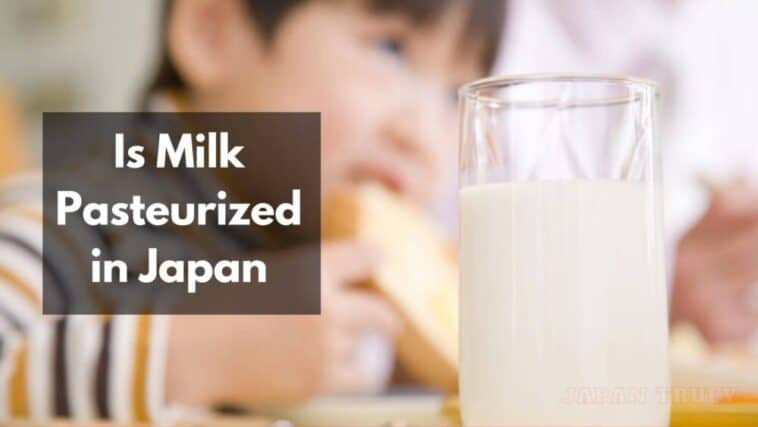If you’re wondering about the quality of milk in Japan, you’re not the only one. And if you’re specifically wondering is milk pasteurized in Japan then you’re at the right spot!
Dive into the dairy practices of Japan, a nation where food safety is paramount, as we examine the pasteurization process of milk.
This exploration will clarify the methods Japan employs to ensure the milk on its shelves is not only safe but also adheres to the country’s stringent health standards.
Page Contents
Is Milk Pasteurized in Japan?
Yes, milk is pasteurized in Japan. Majority of the milk available in the supermarkets are pasteurized and safe to drink. You’ll find the type of milk you want full fat or low fat and they’re all safe to drink. In supermarts, you’ll get pasteurized milk in cartons. But also, it is home delivered in glass bottles.

Many people visiting Japan want to know if milk available in Japan is pasteurized and it’s a valid question.
Several people who have tried milk in Japan have noticed a difference in the taste of milk. And this has caused many people to raise questions like “Why does milk taste different in Japan”? And “Is milk pasteurized in Japan?
There are countless reasons why milk tastes different in Japan compared to other countries but if you want to know if milk is pasteurized in Japan then don’t worry because milk available in most parts of Japan is pasteurized and treated well to ensure it’s safe for consumption.
In addition, there are several types of milk available in Japan that can either be pasteurized at different temperatures or even homogenized milk as well.
Pasteurized milk is different from homogenized milk. When milk undergoes the pasteurization process, it’s heated slowly at around 140 F for almost 20 minutes and this will make sure that all the microbes are killed in the process.
Meanwhile, homogenization involves evenly distributing the fat globules in milk which prevents a layer of fat from being formed on the milk and the milk isn’t heated when it’s homogenized.
How Is Milk Pasteurized In Japan?
Now that we know the significance of pasteurization it’s best we look at the different types of pasteurization methods carried out in Japan. They are:
- UHT – UHT or Ultra Heat Treatment is a common term in the dairy industry. This refers to the pasteurization process where milk is heated above 280 degrees Fahrenheit for 5 seconds.
- LTLT (Low Treatment Long Time) – This pasteurization method involves heating milk for about 30 minutes at 145 degrees Fahrenheit. This isn’t a widely used pasteurization method nowadays.
- HTST (High Treatment Short Time) – This is one of the popular pasteurization methods that involves heating milk at 160 degrees Fahrenheit for about 10 to 15 seconds.
Since milk is treated and heated at different temperatures and different durations, the taste of each milk variety can be distinct. Some people also believed that pasteurization can deplete certain nutritional elements in the milk, however, this was disproved by the FDA.
Why Is Pasteurization Important?
Pasteurization is a process where certain food and beverages are heated at a specific temperature in order to kill harmful bacteria, dangerous pathogens, and other types of microbes.
Pasteurization is usually carried out on dairy products like milk because milk from animals is susceptible to the growth of bacteria and other microorganisms which can result in people consuming to develop fatal diseases.
Pasteurization is carried out on milk not just to obliterate any dangerous growth of pathogens and bacteria but also to increase the shelf life of milk and milk as we know has a very short shelf life.
By pasteurizing, milk can be kept fresh for a specific period of time without any growth of microbes and be safe for consumption as well.
Why Does Milk In Japan Taste Different?
A lot of foreigners who have been to Japan have complained about a difference in the taste of milk in Japan and this isn’t a real issue if you know why milk tastes different in Japan compared to most countries in the West.
The milk available in Japan is mostly whole milk or full cream milk. This means that the milk has all of the fat content present in it which gives the milk a fatty and creamy taste.
However, milk available in most Western countries is skimmed and toned milk which means the fat content is reduced slightly or completely.
This can cause the milk to have a light consistency and taste hence why most foreigners find milk in Japan to have a distinct taste.
Different Types Of Milk In Japan
There are choices in everything we consume nowadays and this can also apply to milk which comes in various formats.
Likewise, in Japan, there are a couple of milk types available in stores and supermarkets that come from several parts of the country and not all of these types of milk will have the same fat and nutrient content.
In addition, the taste of the milk and also the way they’re treated can differ significantly depending on which type of milk you want to purchase. Therefore, let’s take a look at the types of milk that are prevalent in Japan.
Full-Fat Milk / Whole Milk
This is one of the most common types of milk that’s available in Japan and one of the most frequently consumed milk varieties as well. Full fat milk contains between 3 to 4 percent of fat and depending on the brand some full-fat milk might contain even 5% of fat. The taste of full-fat milk is creamy and the consistency is quite thick. It’s also the ideal milk variety for kids and young adults.
Low Fat Milk
As the name suggests, low-fat milk is a milk variety where the fat content is partially removed. The fat content in low-fat milk is generally below 2% and it’s ideal for elders and those who want to switch to a healthier diet.
Non-Fat Milk
Nonfat milk is the milk variety where all the fat content is drained off which generally has about less than 1% of fat which makes it the ideal milk for those on a strict diet.
Processed Milk
Processed milk is not a common milk variety and this milk contains other ingredients like concentrated milk, buttermilk, cream, etc
Apart from these milk varieties, there are also other milk-based beverages available in Japan such as yogurt drinks, and milk with additives and flavors, and they’re consumed occasionally depending on the person’s tastes.
Since there are varieties of milk to choose from, each milk can taste different and it’s also worth noting that each milk brand might have a different smell, consistency, and taste.
You can choose the milk you prefer simply by looking at the label of milk cartons and bottles to identify which milk suits your tastes and preferences.
It’s also best to mention that all these types of milk available in Japan are pasteurized at different temperatures making them safe and ideal for consumption.
What Should I Know Before Buying Milk In Japan?
If you’re visiting Japan for the first time and don’t speak the Japanese language then you’ll have a bit of trouble identifying the milk you want to purchase.
Hence, you can identify milk if you simply say “Miruku” to the shopkeeper or you can also take a look at milk cartons and bottles to see if the following kanji characters are written “ミルク”.
Another simple way to identify which type of milk you’re buying in Japan is by looking at the label and if the label states 100% it means the milk in the carton or bottle is real milk.
On the contrary, if the carton displays less than 100% then the milk contains other additives and flavors hence it only becomes a milk-based beverage.
If you want to purchase milk based on its fat content then you have to take a look at the label, generally on the 4th line where the fat content percentage of the milk is indicated.
If the label indicates above 3% then it’s full-fat milk and if it’s anywhere below 1% then it’s low fat or nonfat milk.
Japan’s Dairy Industry
Since Japan is a small island nation, the pastures and meadows are very low hence there’s a need for Japan to import most of its dairy from other countries. Countries that import dairy goods to Japan are Australia, Singapore, Thailand, and Indonesia.
Hence, the milk you buy in stores in Japan doesn’t necessarily mean it’s produced in Japan.
This can also influence the taste of the milk which can vary between different brands because the cows grazing in other countries tends to give milk that tastes slightly different.
Moreover, you can rest assured that any type of milk available in Japan, either full fat or nonfat is pasteurized and hence they’re ideal for consumption undoubtedly.
Is Milk Pasteurized In Japan: FAQs
Is milk in Japan UHT?
UHT or Ultra High Treatment is one of the common milk pasteurization methods which involves heating milk at 280 degrees Fahrenheit for 5 seconds.
There are a few types of milk available in Japan and UHT milk is one of them. You can find UHT milk in Japan which mostly comes in cartons, however, UHT milk isn’t widely available in Japan.
The most common type of pasteurization in Japan is HTST which means High Treatment Short Time which involves heating milk at 160 degrees Fahrenheit for 10 minutes.
Why is Japanese milk different?
Milk in Japan can taste and look different because there are several varieties of milk available in the stores. One of the most frequently consumed milk in Japan is full-fat milk or whole milk. This means that the milk has all of its fat content and the percentage can range between 3 to 4 percent. Full fat milk tastes distinct from skimmed and low-fat milk where the level of fat is reduced when treated.
What kind of milk is used in Japan?
Milk consumed in Japan is most full-fat milk which is also known as whole milk. Full fat milk contains a fat content percentage of above 3% and it comes in milk cartons and bottles after undergoing pasteurization. This type of milk is called “Gyunu” in Japanese and it translates to cow’s milk in English.





